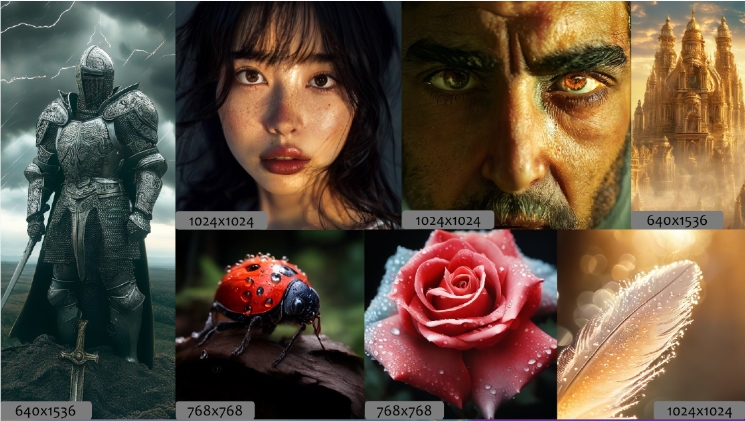Multimodal generative models are becoming a focus in the field of artificial intelligence, with the goal of fusing visual and textual data to create powerful multi-task systems. However, the progress of autoregressive (AR) models in the field of image generation lags behind diffusion models. This article will introduce Lumina-mGPT, an advanced AR model developed by researchers from the Shanghai AI Laboratory and the Chinese University of Hong Kong. It aims to overcome the limitations of existing AR models in terms of image quality, resolution flexibility, and multi-tasking. A breakthrough in processing power.
Multimodal generative models are leading the latest trend in artificial intelligence, focusing on fusing visual and textual data to create systems that can complete a variety of tasks. These tasks range from generating high-detailed images based on text descriptions to understanding and reasoning across data types, driving the birth of more interactive and intelligent AI systems that seamlessly integrate vision and language.
In this area, a key challenge is to develop autoregressive (AR) models that are capable of generating realistic images based on textual descriptions. Although diffusion models have made significant progress in this field, the performance of autoregressive models has lagged behind, especially in terms of image quality, resolution flexibility, and the ability to handle a variety of visual tasks. This gap has prompted researchers to look for innovative ways to improve the capabilities of AR models.

Currently, the field of text-to-image generation is mostly occupied by diffusion models, which excel at generating high-quality, visually appealing images. However, AR models like LlamaGen and Parti fall short in this aspect. They often rely on complex encoding-decoding architectures and can often only produce fixed-resolution images. This limitation greatly reduces their flexibility and effectiveness in generating diverse, high-resolution output.
To break this bottleneck, researchers from the Shanghai AI Laboratory and the Chinese University of Hong Kong launched Lumina-mGPT, an advanced AR model designed to overcome these limitations. Lumina-mGPT is based on a decoder-only transformer architecture and adopts the multi-modal generative pre-training (mGPT) method. This model integrates vision and language tasks into a unified framework, aiming to achieve the same level of realistic image generation as the diffusion model, while maintaining the simplicity and scalability of the AR method.

Lumina-mGPT takes an exhaustive approach to enhancing image generation capabilities, with a flexible progressive supervised fine-tuning (FP-SFT) strategy at its core. This strategy progressively trains the model to generate high-resolution images from low resolution, first learning general visual concepts at lower resolutions and then gradually introducing more complex high-resolution details. Additionally, the model introduces an innovative unambiguous image representation system that eliminates the ambiguities associated with variable image resolutions and aspect ratios by introducing specific height and width indicators and end-of-line markers.
In terms of performance, Lumina-mGPT significantly surpasses previous AR models in generating realistic images. It is capable of generating high-resolution images of 1024×1024 pixels, rich in detail, and highly consistent with the provided text prompts. The researchers report that Lumina-mGPT requires only 10 million image-text pairs for training, far less than the 5 million image-text pairs required by LlamaGen. Despite the smaller dataset, Lumina-mGPT outperforms competitors in image quality and visual consistency. In addition, the model supports a variety of tasks such as visual question answering, dense annotation, and controllable image generation, demonstrating its flexibility as a multi-modal generalist.
Its flexible and scalable architecture further enhances Lumina-mGPT's ability to generate diverse, high-quality images. This model uses advanced decoding techniques such as classifier-free guidance (CFG), which plays an important role in improving the quality of the generated images. For example, by adjusting parameters such as temperature and top-k value, Lumina-mGPT can control the details and diversity of the generated images, helping to reduce visual artifacts and improve the overall beauty.
Lumina-mGPT marks a significant advance in the field of autoregressive image generation. This model, developed by researchers from the Shanghai AI Laboratory and the Chinese University of Hong Kong, successfully bridges the AR model and the diffusion model, providing a powerful new tool for generating realistic images from text. Its innovative methods in multi-modal pre-training and flexible fine-tuning demonstrate the potential transformative capabilities of AR models and herald the birth of more complex and versatile AI systems in the future.
Project address: https://top.aibase.com/tool/lumina-mgpt
Online trial address: https://106.14.2.150:10020/
All in all, the emergence of Lumina-mGPT has brought new possibilities to the field of autoregressive image generation, and its efficient training method and excellent generation effect are worthy of attention. In the future, we can look forward to more innovative applications based on similar technologies to promote the continued development of the field of artificial intelligence.